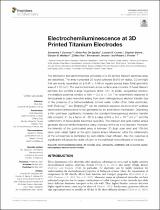Electrochemiluminescence at 3D Printed Titanium Electrodes

View/
Date
2021Author
Douman, Samantha F
De Eguilaz, Miren Ruiz
Cumba, Loanda R
Metadata
Show full item recordAbstract
The fabrication and electrochemical properties of a 3D printed titanium electrode array
are described. The array comprises 25 round cylinders (0.015 cm radius, 0.3 cm high)
that are evenly separated on a 0.48 × 0.48 cm square porous base (total geometric
area of 1.32 cm2
). The electrochemically active surface area consists of fused titanium
particles and exhibits a large roughness factor ≈17. In acidic, oxygenated solution,
the available potential window is from ∼-0.3 to +1.2 V. The voltammetric response of
ferrocyanide is quasi-reversible arising from slow heterogeneous electron transfer due
to the presence of a native/oxidatively formed oxide. Unlike other metal electrodes,
both [Ru(bpy)3]
1+ and [Ru(bpy)3]
3+ can be created in aqueous solutions which enables
electrochemiluminescence to be generated by an annihilation mechanism. Depositing
a thin gold layer significantly increases the standard heterogeneous electron transfer
rate constant, ko
, by a factor of ∼80 to a value of 8.0 ± 0.4 × 10−3 cm s−1 and the
voltammetry of ferrocyanide becomes reversible. The titanium and gold coated arrays
generate electrochemiluminescence using tri-propyl amine as a co-reactant. However,
the intensity of the gold-coated array is between 30 (high scan rate) and 100-fold
(slow scan rates) higher at the gold coated arrays. Moreover, while the voltammetry
of the luminophore is dominated by semi-infinite linear diffusion, the ECL response is
significantly influenced by radial diffusion to the individual microcylinders of the array.
